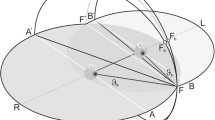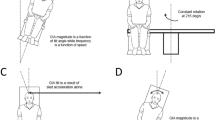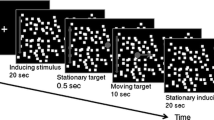Abstract
Torsional eye movements were measured while subjects viewed a large, high contrast windmill pattern rotating at 53°/s or a small (5° diameter) dot pattern rotating at 115°/s. Both stimuli generated rotational eye movements consisting of torsional optokinetic nystagmus (tOKN) superimposed on a slow torsional drift in the direction of pattern rotation. With the wide-field windmill stimulus, torsional drifts of up to 7° over 20 s were found. The dot pattern produced drifts of up to 2° over 5–20 s. In both cases, the slow-phase speeds during tOKN were low (0.5–1°/s). We conclude that reductions in slip speed are minimal with rotating stimuli, so torsional eye speeds will have a minimal effect on investigations of rotational motion aftereffect strength and perceived speed. While the slow-phase tOKN gain is low, the slow drift in torsional eye position will have significant effects on psychophysical results when the tests rely on keeping selected regions of the stimulus confined to specific areas of the retina, as is the case for phantom or remote motion aftereffects.


Similar content being viewed by others
References
Barnes GR, Crombie JW (1985) The interaction of conflicting retinal motion stimuli in oculomotor control. Exp Brain Res 59:548–558
Bergamin O, Ramat S, Straumann D, Zee DS (2004) Influence of orientation of exiting wire of search coil annulus on torsion after saccades. Invest Ophthalmol Vis Sci 45:131–137
Bex PJ, Makous W (1997) Radial motion looks faster. Vision Res 37:3399–3405
Bex PJ, Metha AB, Makous W (1999) Enhanced motion aftereffect for complex motion. Vision Res 39:229–2238
Clifford CWG, Beardsley SA, Vaina LM (1999) The perception and discrimination of speed in complex motion. Vision Res 39:2213–2227
Crone RA (1975) Optically induced eye torsion. II. Optostatic and optokinetic cycloversion. Albrecht Von Graefes Arch Klin Exp Ophthalmol 196:1–7
Dichgans J, Jung R (1969) Attention, eye movements and motion detection: facilitation and selection in optokinetic nystagmus and railway nystagmus. In: Evans CR, Mulholand TB (eds) Attention in neurobiology. Appleton-Century-Croft, New York
Farooq SJ, Proudlock FA, Gottlob I (2004) Torsional optokinetic nystagmus: normal response characteristics. Brit J Ophthalmol 88:796–802
Geesaman BJ, Qian N (1996) A novel speed illusion involving expansion and rotation patterns. Vision Res 36:3281–3292
Geesaman BJ, Qian N (1998) The effect of complex motion pattern on speed perception. Vision Res 38:1223–1231
Howard IP, Rogers BJ (1995) Vergence eye movements. In: Binocular vision and stereopsis. Oxford University Press, Oxford, UK
Howard IP, Sun L, Shen X (1994) Cycloversion and cyclovergence: the effects of the area and position of the visual display. Exp Brain Res 100:509–514
Price NS, Greenwood JA, Ibbotson MR (2004) Tuning properties of radial phantom motion aftereffects. Vision Res 44:1971–1979
Seidman SH, Leigh RJ, Thomas CW (1992) Eye movements during motion after-effect. Vision Res 32:167–171
Snowden RJ, Milne AB (1997) Phantom motion aftereffects—Evidence of detectors for the analysis of optic flow. Current Biology 7:717–722
Suzuki Y, Shinmei Y, Nara H, Ifukube T (2000) Effects of a fixation target on torsional optokinetic nystagmus. Invest Ophth Vis Sci 41:2954–2959
Van Rijn LJ, Van der Steen J, Collewijn H (1994) Instability of ocular torsion during fixation: cyclovergence is more stable than cycloversion. Vision Res 34:1077–1087
von Grunau MW, Dube S (1992) Comparing local and remote motion aftereffects. Spatial Vision 6:303–314
Author information
Authors and Affiliations
Corresponding author
Rights and permissions
About this article
Cite this article
Ibbotson, M.R., Price, N.S.C., Das, V.E. et al. Torsional eye movements during psychophysical testing with rotating patterns. Exp Brain Res 160, 264–267 (2005). https://doi.org/10.1007/s00221-004-2142-4
Received:
Accepted:
Published:
Issue Date:
DOI: https://doi.org/10.1007/s00221-004-2142-4




